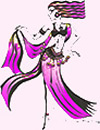Ethnic Dance Expressions
School of Belly Dance
Gainesville, Florida
 Sallamah has compiled some practical words of wisdom to dance by based on her own learning and teaching experiences. They will apply to you in stages as you grow and develop into a dancer.
Sallamah has compiled some practical words of wisdom to dance by based on her own learning and teaching experiences. They will apply to you in stages as you grow and develop into a dancer.
Words of Wisdom to Dance By
- You don't need a perfect body to dance; you need feeling for the movement and music; a sense of rhythm, and good coordination. These are things that can be learned and perfected as long as you have a real desire to dance.
- Learn how to work with your body and make the most of it. Your body type will determine the way you move and how movements look on you.
- Dance is about self-discovery of your own unique capacity for movement. Technique is built upon your actual capabilities and body construction and not on what you wish they were.
- The dance class is a laboratory, a place to work and to try out new things. Don't fret or try to hide your mistakes--learn from them.
- Beginner dance students would be wise to come to class as free as possible of expectations. Learning to dance takes time, cultivation, and a real sense of humor.
- Don't compare yourself to your classmates and don't worry about how you long it is taking you to learn. There will always be students more and less advanced than you are.
- A correction from your teacher is not a put down but an indication of her belief in your ability to make changes and progress. A teacher who doesn't give feedback isn't really teaching. Select a teacher who can mentor you and isn't self-absorbed in her own dancing. Learning to dance involves constant corrections; Otherwise how do you know if what you are doing is right or wrong?
- Beginner students should wait several weeks before trying to practice technique. They should practice their basic stance, muscle isolations, and work at improving their posture. Experimenting with your body between classes helps you learn where your muscles are and how to isolate them.
- Give yourself a least 16 weeks to decide if you are making any progress. The measure of your progress is the improvement of your own insight and ability over what it was in the past weeks or months. Here are the signs of progress:
a) You are enjoying yourself and can do things with your body you couldn't do before.
b) You are feeling new sensations in your body.
c) You look better and your body is responding.
d) You can pick up the steps faster as your mind/body connection improves.
e) Your dancing has consistency.
f) You have more confidence and a stronger sense of yourself as a dancer. - Learning to dance is a partnership between you and your teacher. Both parties have expectations and both must realize that becoming a dancer is an eventuality not a instantly attainable goal. So when you are frustrated about your real or imagined lack of progress come back to these words of wisdom:
Students should realize: If I want to do it right eventually, I have to be willing to it wrong for a while.
Teachers should realize: If I want to see it done right eventually, I have to be willing to see it wrong for a while.
My last thought is this, make sure you attend as many classes as you can. Attaining physical goals is much more challenging than reading a book and taking a test on the material. Dancing and exercising require a mind and body reconnect or body recall. As we age, our bodies no longer respond to our mental commands. We have lost the mental awareness of how to make our bodies physically do what we want them to do. Unlike a child, we now know how to walk, climb, ride a bike, cut a slice of bread, so we no longer go through the mind/body process to do these simple activities. Coming to classes regularly, helps us ingrain the movements into our muscle memory and regain control over our body. It takes 70,000 repetitions to place a movement in our muscle memory.
 Ethnic Dance Expressions
Ethnic Dance Expressions